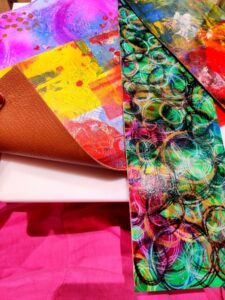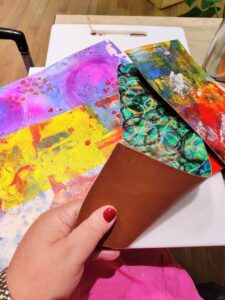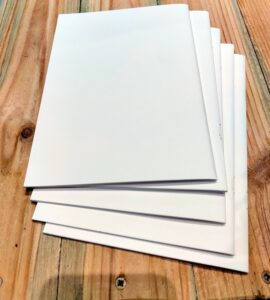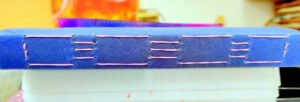Having written about teaching gel plate printing to both children and adults, I wanted to share what can happen next to those pieces of work. Many of you will know that I am a painter, printmaker and journal maker/bookbinder. A few years ago, I found a way that I could combine the three areas I love working with into one.
It came about simply because I had so many works on paper, most of which I was happy with so didn’t want to destroy, but which were not suitable for framing and adding to my shop. I had literally hundreds of pieces of paper, mostly in size A1, so pretty big, which I was storing until my mind caught up and realised what I could do with them.
I had created them as part of my experimentation into working with my first love – colour – and then as the relevance of the circle became clearer, how I could incorporate those circles, which represent hugs to me, into my work. As you can imagine I had quite a lot to work with.
So initially I cut up the papers, selecting the areas I was really happy with, and attached them to large sheets of leather (usually sheep or goatskin but sometimes cowhide) using a mixture of PVA, school glue, and about 20% wood glue and then placed them into my press for at least 24 hours. When gluing paper to leather in this way, make sure to start in the centre of the paper and work towards the edges ensuring that there is plenty of glue on the edges to stop the paper and leather from separating.




I have always tried to use as much of the paper artwork and leather as possible simply because of my concern for how as a society we throw so much away when it could so easily be re-purposed and/or reused. This often means that the journals or books I make are non-standard paper sizes.
The leather I buy from the tanners in Northampton is the off cuts from their main business, which is to supply the auto, footwear and furniture trades. If people like me did not buy it, it would finish up in landfill, which is abhorrent, to me at least. I can make journals/books from very small to A2 in size, although I tend to make them about A5 as it feels like a comfortable size to hold in one’s hand.
Whilst the paper and leather are in the press bonding together, I start on the insides. The collection of pages is sorted out into sheets of between six and eight A4 size which I fold in half with something called a bone folder (or you can use a credit or gift card). You rub it over the folds to make sure they are well creased. I then place these under a couple of weights on top of a book to squash them a bit more. How these are stitched together all depends on the style of journal or book I am making. If it is a traveler journal, each section (or signature) is stitched in isolation and joined to the cover using elastic so that the signatures can be removed and replaced.

Every year I make myself a personal journal with special pages in just for me to record my activities and my thoughts. When I make a journal for myself, I can choose the leather, lining and stitching and this year’s journal was made using a very complex cross stitch. It takes a while to do but looks fantastic in my opinion and I am happy to treat myself to one of these every year. Generally, though I teach a much easier stitch for beginner students as we all need to learn to walk before we can run.
As well as using leather I have made a few journals using a product called Kraft-Tex, simply because there is a need to provide a vegan alternative to the leather journals. The process of making the journals is exactly the same using this product. The primary difference is that it comes in plain, white sheets and needs to be decorated, preferably before constructing into a journal, though that can be done afterwards if necessary.
Kraft-Tex is an eco-friendly, vegan, paper-based material which is extremely flexible in that it can be used in place of, or in addition to leather or fabric. It can be washed, it cuts easily, can be glued or stitched and it has the feel of leather as well as acting like it, in that over time it softens.
This product can be used for all sorts of things, but for example, you could produce make-up bags or pencil cases, which may contain items that are messy, as the fabric is so easy to clean. It can also be used to make purses, bags, wallets, shoes but obviously in my case I use it to make journal covers.
Using it myself I have painted on it with acrylic paint, acrylic ink and I have used both monoprinting techniques and lino prints as well. I haven’t tried it, but you can put it through your printer, too. As a product we should all be seeing more of in our homes; it is perfect from an eco-standpoint as it is made of cellulose and wood fibres. It really is the future of packaging.
You can buy Kraft-Tex in its original unwashed form, which has a smooth surface and is a little stiff when first opened. If you want to have more texture, you can put it through your washer dryer. Pre-washed Kraft-Tex is more like leather when you buy it.
You can also use it for making embroidery pieces and I am in the process of making some dolls clothes, which I will embellish with beads, sequins and embroidery stitches. I have also seen it painted, cut into strips and then used to weave into fabric strips to make table settings. All in all, it’s an amazing product which you can experiment with and have great fun.
However, in my classes I only use it for book covers, because that is what I teach, but you can glue napkins to it to make a series of books which all look the same if you have a group of people you want to treat in the same way.
So, if you are interested in having a go at making journals or books and you would like to try using either leather or Kraft-Tex, hop on over to my website https://alisongsaunders.co.uk/class-bookings/ and book a class with me, or if you don’t see what you want, do drop me an email to alison@alisongsaunders.co.uk and I will happily arrange something to suit you.

NB Just for the record, I do not get paid to endorse any of the brands I have mentioned above.
If you have enjoyed reading this post, please like and follow me and please share it with people who you think might be interested. I am always on the lookout for new artists to feature as I know how much everyone enjoys reading about other artists. Also, if you think there is a subject you would like to know more about and would like me to write about, I will be happy to consider it. Sharing, liking and following my blogs increases the number of people the algorithm shows the blogs to, so please share. Thank you in advance for supporting me this way.
